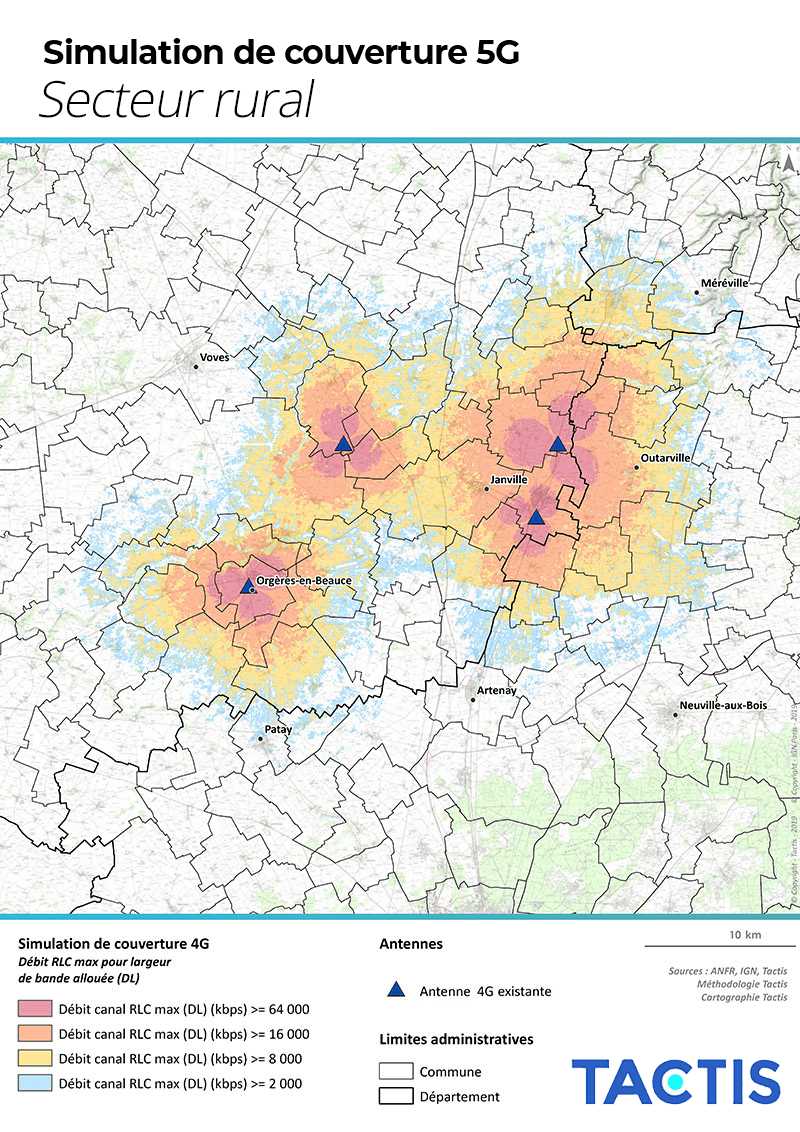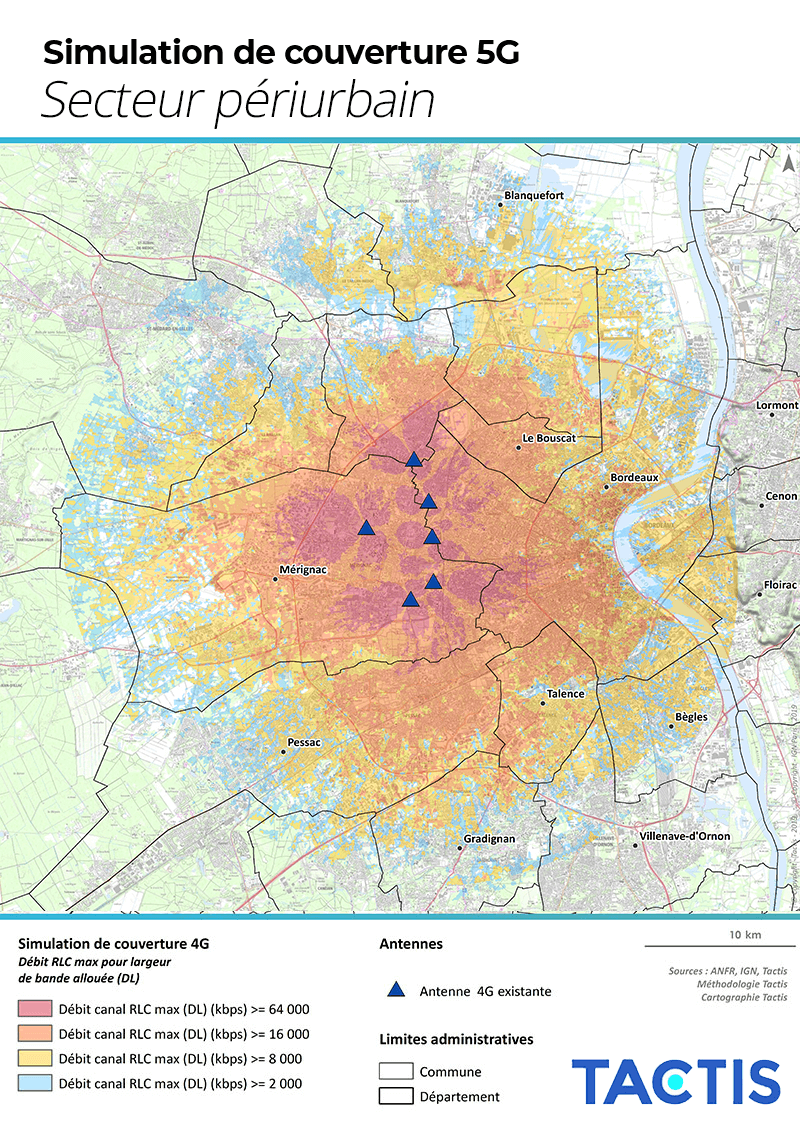A reminder of the frequency bands used by 5G
The 3 frequency bands identified for 5G:
- The 700 MHz band, which has already been allocated to mobile telephone operators (Bouygues Telecom, Free, SFR and Orange in France), carries a long way and can penetrate buildings. However, it does not allow high data rates, mainly because the allocated spectrum is limited to 30 MHz duplex (5 to 10 MHz duplex per operator);
- The 3.5 GHz band, which is in the process of being allocated, is capable of delivering high and very high bandwidth, since no less than 310 MHz duplex will be allocated (between 50 and 100 MHz duplex per operator), but its range and propagation capabilities in buildings are less (see below);
- The 26 GHz band, for which the allocation timetable has not yet been decided, which will provide access to the promises of 5G (ultra-high speed, very low latency, etc.), but with coverage limited to small cells with a radius of around 100 metres.
Gradual upgrading of operators' sites
In France, the obligations to be met by those allocated the 3.5 GHz frequency bands include those relating to territorial coverage, which, for the first time, are expressed in terms of the number of sites, rather than the rate of mobile coverage to be achieved:
| 2022/12/31 | 2024/12/31 | 2025/12/31 | 2030/12/31 | |
| Number of 5G sites opened (by operator) | 3 000 | 8 000 | 10 500 | 100% of the operator's existing sites |
In addition, in 2024 and 2025, 25% of the number of 5G sites deployed in France will have to be located in a ‘rural’ zone, defined as all the communes included in the 4G ‘priority deployment zone’ and the communes in the ‘industry territories’ located outside urban units with more than 50,000 inhabitants, i.e. a total of around 26,000 communes representing 30% of the population.
So, while on 1 January 2020, the Agence Nationale des Fréquences (ANFr) counted almost 50,000 4G sites authorised to transmit in mainland France (all operators combined), it is possible to consider that the upgrading to 5G of the operators' sites (Bouygues Telecom, Free, SFR and Orange) will take place very gradually, possibly over a period of ten years, and will only affect rural areas very sparingly.
Much less coverage with 5G
In fact, in order to obtain 3.5 GHz frequencies, operators (SFR, Orange, Free, Bouygues Telecom) will not be obliged to create new sites.
So, with a view to the future allocation of licences to use frequencies in the 3.5 GHz band, Tactis, a consultancy firm, has looked at propagation capabilities in this band. To this end, using ATOLL radio network simulation software, we simulated a 5G network in the 3.5 GHz band on different topologies of the country, and compared it with the coverage of the 4G network in the 800 MHz band simulated from the same sites.
These simulations show a deterioration in 5G coverage and service levels for a constant number of sites.
4G
5G
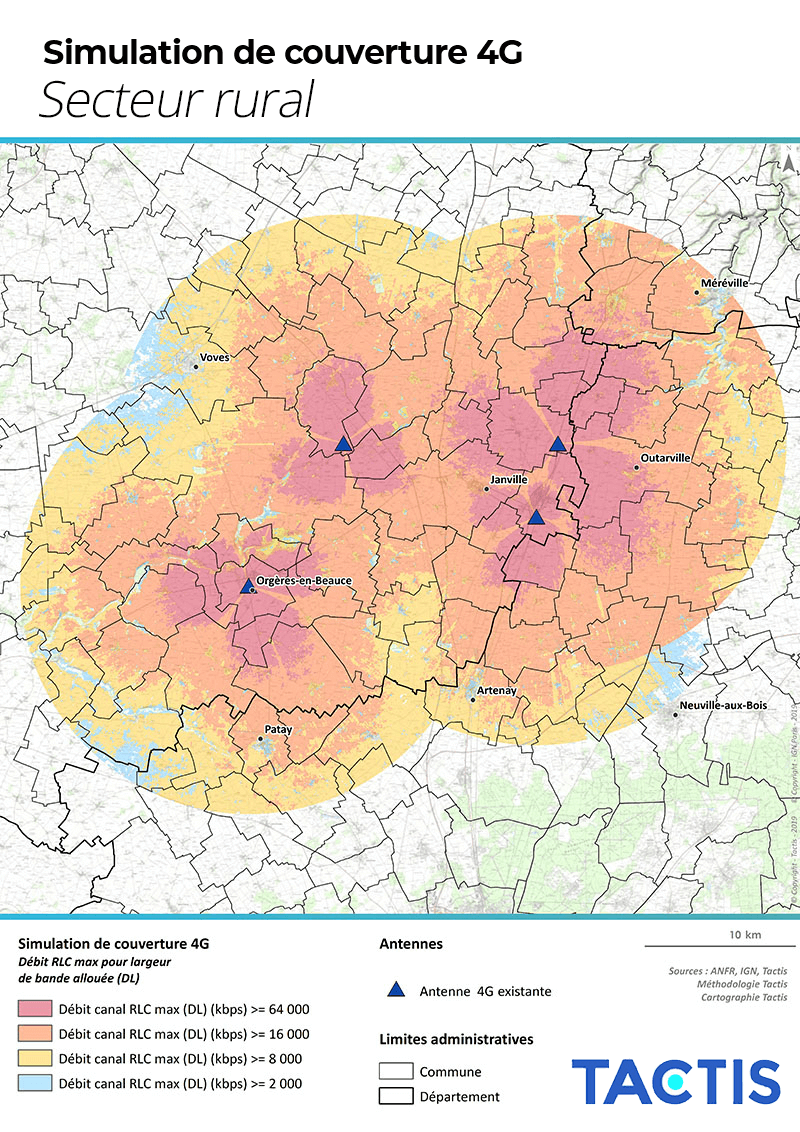
4G
5G
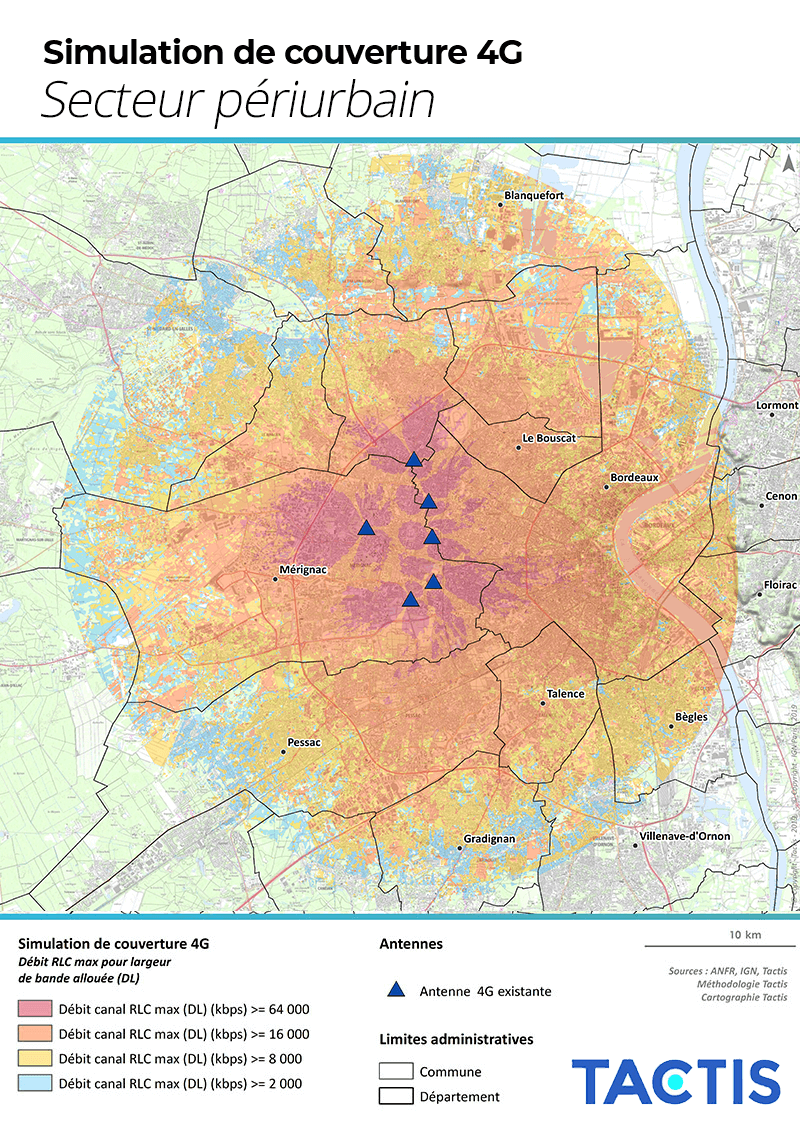
More specifically, by extrapolating these simulations to mainland France, we can see that :
- In peri-urban areas, 30% more sites would be needed in 5G to maintain coverage and a level of service equivalent to 4G ;
- In a rural environment, it would be necessary to build twice as many sites to have equivalent coverage, and even 3 times as many sites to deliver a broadband service of at least 8 Mbps.
Over and above these coverage concerns, as we are already seeing with 4G, network densification leading to the creation of additional sites is necessary to absorb the growing demand for capacity.
These potential new sites will also need a fibre optic connection to deliver the performance expected from 5G. Local authorities in public-initiative areas must therefore take this need into account as of now, by planning to connect these additional antennas.
In conclusion:
As we have seen, the 3.5 GHz band is necessary for access to the broadband promised by 5G: rollouts in the 700 MHz band will provide 5G coverage, but not the speed needed for ‘good’ 5G.
Deployments in the 3.5 GHz band will be concentrated primarily in densely populated areas, neglecting the most rural parts of the country.
What's more, the propagation properties in this band are such that, to achieve equivalent levels of coverage and services, networks will have to be massively densified, whatever the type of area under consideration. And the less dense the environment, the more this will be necessary, with three times as many masts needed to hope to provide a ‘high-speed’ service (8 Mbps) over a coverage area equivalent to that provided by 4G at 800 MHz.
If the regions do not take up this issue now, in particular through the targeted coverage mechanism of the New Deal Mobile, which enables them to guide the deployment of operators, the hopes born of the implementation of this same New Deal to reduce the digital divide could then remain in vain.
TACTIS is supporting a quarter of the French départements as part of the Mobile New Deal, as well as two 5G experimentation platforms in the 26 GHz band[3]. This experience has already enabled us to support local authorities in preparing and promoting the deployment of 5G in their areas.
What's more, as a leading provider of project management assistance to local authorities for their public-initiative networks, TACTIS will be able to advise them on the fibre connection of future masts in their areas.
Definition: What is 5G?
5G is the new generation of mobile networks introduced by the telecoms industry. It is a response to the International Telecommunication Union's (ITU) ‘IMT-2020’ initiative, which defines the broad categories of performance that these new technologies will make it possible to achieve.
While the introduction of new frequencies will bring more capacity to mobile networks (which should be saturated by 2020 in the densest areas), the promises of 5G hinge above all on a number of major technological breakthroughs in wireless communications.
What does 5G promise?
The 5G connection will do more than just improve speeds: it will also guarantee the development of new, ever more instantaneous uses and cover the specific needs of innovation in a variety of sectors.
Mobile ultra broadband
5G promises to deliver speeds up to 10 times faster than 4G, in line with ever-increasing demand. This is thanks to :
- New coding techniques for radio signals to increase the number of bits transmitted per hertz,
- Expanding radio bands: 5G plans to use higher bands than those used until now (e.g. 26 GHz). These are the so-called ‘millimetre’ bands, which have a large amount of spectrum available.
An ultra-reliable, low-latency network
More than speed, 5G will probably make the difference by guaranteeing a high level of communications reliability.
Indeed, 5G will offer ultra-reliable communications thanks to better management of interference, which is a source of data loss. Latency, i.e. the time taken to transmit a communication, will be divided by 10.
The massive Internet of Things (IoT)
The very low latency offered by 5G opens up prospects for interactivity and remote control of precision objects that will revolutionise the way we use technology.
5G will make it possible to have a higher density of connected objects than we have today, with much lower energy consumption per object (which will substantially increase the lifespan of these objects' batteries). Among other things, 5G will make it possible to transmit only where and when necessary, adapting transmission power to usage.
How does 5G work?
5G is based on an intelligent network that offers different performances depending on the targeted uses (network slicing). This network can be reconfigured dynamically.
For example, for ultra-high-speed requirements such as 4K, 8K, 3D or VR (virtual reality) video, the network will offer maximum throughput and high capacity. To manage connected objects, the network will concentrate its resources on managing a large number of simultaneous connections. Finally, when ultra-reliable communications with very low latency are required, maximum performance will be achieved by reducing the number of simultaneous communications or the data rate.
What are the challenges of 5G?
The industrial challenges of 5G in France
In France, the telecoms sector accounted for €75 billion in revenue, 166,000 direct jobs, and €10 billion in investment in 2017.
The government is currently supporting a number of 5G-related R&D projects with the aim of fostering the development of a range of technologies and services.
Beyond the telecommunications sector, 5G promises to be a driver of digital transformation for all industry (automotive, transport, energy, smart cities, agriculture, etc.) with the new uses it enables and the prospects it offers in terms of competitiveness.
Below is a non-exhaustive list of the new industrial opportunities offered by 5G:
- Remote monitoring, control and reconfiguration of industrial machines and robotised production lines that can be reconfigured quickly and easily,
- End-to-end logistical tracking of very large numbers of parcels or items, particularly in large sortation hubs (e.g. ports, railway stations, airports, etc.).
- Tele-operations of all kinds (e.g. in healthcare, mining, etc.) thanks to low latency and UHD video exchanges,
- Precise monitoring of herds on farms using sensors on the livestock.
The challenges of 5G for the general public
Following on from the uses enabled by 4G, 5G will find applications for the general public. Here are just a few examples:
- Downstream and upstream streaming of UHD videos,
- 360° virtual reality with wireless connectivity for a wide range of uses (e.g. games, education, professional training, tourism, etc.),
- High-speed, low-latency connectivity for vehicles and transport infrastructure (e.g. for connected vehicles, entertainment, etc.),
- Recovering data from the smart city of tomorrow, for example, to check road flows and the various levels of pollution.
Technical challenges of 5G
The implementation of 5G will also present many technical challenges such as:
- Network densification. The use of 5G will force operators to increase the number of antennas in urban areas, or even to install antennas at street level (small sales). As with 4G, operators will certainly have to deal with public acceptance of these rollouts,
- Financing. Massive deployment of 5G will require heavy investment from mobile operators. Monetising these investments with subscribers or finding sources of financing will be a real challenge in a highly competitive environment,
- Indoor coverage. Aiming for very high data rates requires the use of high frequencies and broadband signals, making it even more difficult to penetrate inside buildings. Given the explosion in indoor data traffic, this is likely to become a major concern for operators,
- National regulation. Unlike previous frequency allocations (e.g. 4G), complete coverage of the territory is not realistic from an economic point of view because of the high frequencies involved. The regulatory authority will have to strike the right balance between economic constraints and the need for territorial equality,
- The physical limits of millimetre waves. Networks operating on 26 GHz frequencies will have very limited ranges and will be sensitive to obstacles. Finding uses that incorporate these constraints will be a challenge.
The first steps towards 5G in France
France at the heart of a coordinated European approach
France's digital strategy is part of a coordinated European approach (Europe 2020 Strategy). In September 2016, the European Commission announced an initial action plan for 5G. In addition to issues relating to the harmonisation of frequencies and their allocation, the Commission encouraged experimentation with new uses of 5G.
In July 2017, at the informal European Council in Tallinn, the Member States committed to positioning Europe as a leader in 5G. Policies favourable to its development are being put in place.
The 2018 European Electronic Communications Code has also established regulatory conditions conducive to the deployment of these new networks. The Council, the Parliament and the European Commission have reached agreement on new spectrum management rules, including a minimum duration for authorisations, and a common date for granting authorisations in the 3.5 GHz and 26 GHz 5G bands: 31 December 2020.
France's 5G mobile network objectives
On 16 July 2018, the Government and Arcep published a 5G roadmap that is in line with the European timetable and outlines a national ambition to boost competitiveness and innovation in many economic sectors through the introduction of 5G.
The objectives of this roadmap include: hosting the world's first 5G applications in industrial areas (e.g. transport, energy, agriculture, etc.) with the launch of several 5G pilots.
In autumn 2019, ARCEP launched the process of allocating frequencies in the 3.5 GHz band for the first commercial rollouts of 5G in at least one major city by the end of 2020, and 5G coverage of major transport routes by 2025.
Frequencies already available for 5G
Two pioneering frequency bands for 5G were identified by the European Union in 2017, and their conditions of use have been harmonised for the whole of the European continent.
5G technology is also being standardised by international bodies. It is expected that international standardisation work will be completed and that the 3.5 GHz and 26 GHz bands will be made available in a coordinated manner in Europe by 2020. Test initiatives are already underway and are expected to multiply between now and then.
In January 2018, Arcep opened a ‘5G pilot’ window with a view to allocating frequency bands to interested players to test the full-scale deployment of 5G pilots (e.g. ports, hospitals, connected roads, etc.) and help tomorrow's business models emerge. In addition to simply providing a framework for the technical validation of network equipment, these trials will enable the first concrete 5G use cases to be tested.
Arcep has identified a number of cities and conurbations with available 3.5 GHz frequencies that could be used for initial trials: These include Lyon, Bordeaux, Nantes, Lille, Le Havre, Saint-Étienne, Douai, Montpellier and Grenoble. In addition to this list, Arcep is examining all applications in the 3.5 GHz and 26 GHz bands.
Fibre and 5G
Finally, the rollout of 5G requires a very extensive fibre optic network to connect the 5G antennas and guarantee high speeds. The France Très Haut Débit (THD) Plan, launched in 2013 to bring THD to everyone by 2022, is largely based on the sustained deployment of fibre-optic networks. The fibre optic network will therefore cover most of France, paving the way for the arrival of 5G.
Further reading:
5G and energy efficiency
The deployment of 5G in France
LPWAN, Lora, 5G: what uses?
[1] By way of illustration, as part of the 26 GHz experimental platform launched by ARCEP, the width of the spectrum allocated is between 200 MHz and 1 GHz.
[2] The 5G antennas used for these simulations are beamforming MIMO antennas, similar to those that will be deployed by operators.
[3] Bordeaux Métropole: intelligent street lighting
Paris La Défense: neutral operator model
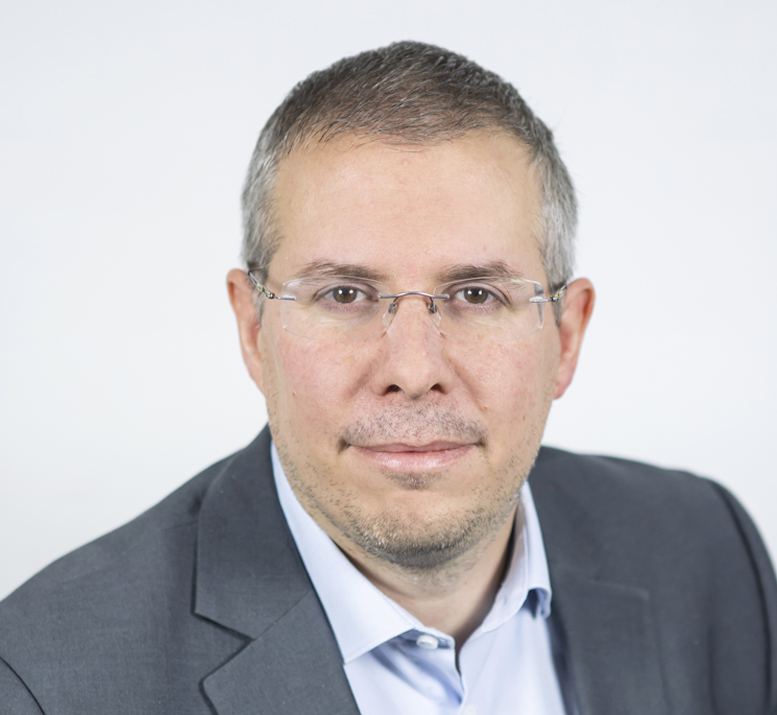
Julien Renard
Contact Julien Renard
Do you have a question about 5G coverage and mobile networks? Send an email to Julien Renard, Tactis radio expert.


